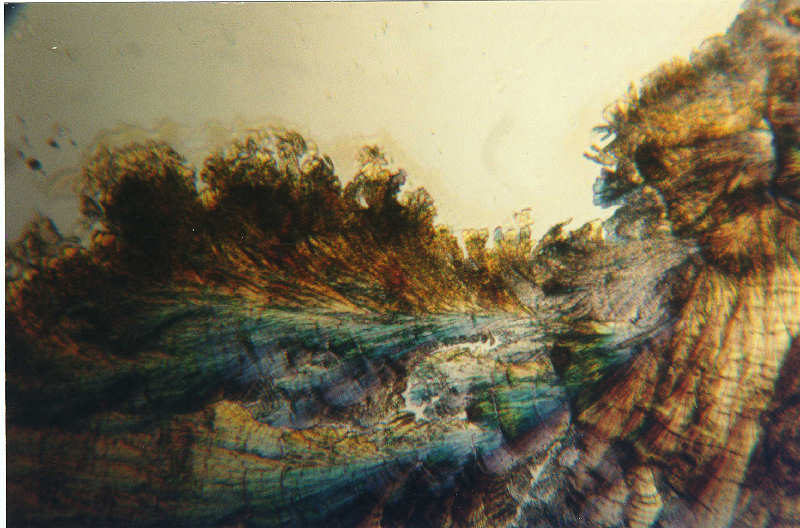Gwyneth Thurgood – micro-artist
By Tony Saunders-Davies
Gwyneth Thurgood is an artist who gets her inspiration from the colourful images that polarised light can make from crystals. She makes paintings and etchings from the “landscapes” which she sees through the microscope.
Here are a couple of her pictures – or rather the crystals which inspired her:
Gwyneth’s pictures
 Exotic Garden
Exotic Garden
This one she calls “Exotic Garden”, and she tells me it was produced by using copper sulphate – something most chemists should be able to provide.
 The Promentory
The Promentory
This one she calls “The Promentory”, and it was made with tartaric acid – again easily obtainable from a high-street chemist. I got mine from my local Boots.
I’m going to ask Gwyneth to tell us more about how she makes these images – for example, how long does she take to dry the crystals?
Watch this space!
You can find out more about Gwyneth, and see more of her pictures, on her website: The Magic of Micro-Art.
Gwyneth Thurgood later contributed this dramatic and beautiful “microscape” and a brief description of how she works:
 The Cave
The Cave
I use microscopic images as inspiration for painting, etching and drawing. I find that using a monocular polarising microscope to conduct experiments with microcrystals heightens my creativity.
Making crystal microscope slides
As the first step in creating crystal microscope slides, I take minute quantities of sulphanilamide crystals on a spatula and place them in the centre of a microscope slide. I then squeeze small droplets of a solvent, such as water or acetone, from a pipette onto the tiny crystals, mixing and agitating the combination. This process causes a solution to form, which then re-crystallises at varying speeds, depending on conditions such as ambient temperature and humidity. I use different approaches during slide preparation, and these often lead to unexpected results. In one approach, when the warm aqueous solution that I have created cools, crystals begin to form.
I then observe the exciting evolution of “landscapes” and “floral” patterns through the microscope, as molecules attain their order. I sometimes heat the solution on the slide using a spirit burner. Other times, I place the slides in a metal tray on top of a warm radiator or near a wood-burning stove, allowing the mixture to slowly evaporate and crystallise from its liquid state. When I use acetone with sulphanilamide, the acetone is absorbed instantaneously, forming floral and butterfly shapes.
When I mix another type of solvent with sulphanilamide and sodium dichromate, beautiful “ferns” and “trees” appear. The formations are reversible: by adding more solvent, the liquid state returns and the mixture reforms into different patterns.
Two micrographs of polarising crystal
 Wave of benzimidazole © 2005 Gwyneth Thurgood
Wave of benzimidazole © 2005 Gwyneth Thurgood
 Urea sequence of 3 stepped micrographs © 2005 Gwyneth Thurgood
Urea sequence of 3 stepped micrographs © 2005 Gwyneth Thurgood

